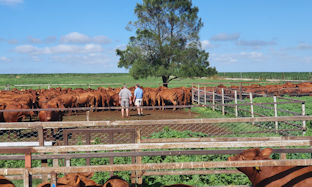
MANAGEMENT OF BEEF CALVES: WEANING - General
Article 7 of 7 in the series on Weaning Time
The following are some general comments of importance in the weaning process:
Weaning process itself
The weaning process, no matter which method is used, places tremendous stress on the calves. At weaning time (±7 months), the contribution of the cow's milk to the calf's nutrition is very limited, but the bond between the cow and the calf is still strong. Low-stress weaning techniques are strongly recommended and support good animal welfare and disease prevention in newly weaned calves, with a concomitant reduction in the use of antibiotics. The use of a "2-stage" weaning technique places the least stress on the calves.
The system that most likely causes the least stress, is by placing "weaning nose rings" on the calves, while they are still with the cows. The nose ring makes it difficult for the calf to suckle, as it "tickles" the cow when the calf tries to suckle. After a few days the calf will then stop trying and the calf is then weaned. Nose rings must be inserted at least 10 days before the planned weaning date and then removed again on the day of weaning. Although nose rings have a cost factor, they are reusable. (The time, labor, cost vs reduced weaning shock?)
With the weaning technique where calves and cows are separated and run in adjacent camps (with a very good fence in between) before they are finally separated, weaning shock is also reduced. Cows and calves can therefore see and smell each other, but the calves cannot suckle. The cows and calves get used to it relatively quickly and can then finally be separated.
The weaning process that places the most stress on the calf, is where the calves are removed directly from the cows and transported to an auction, feedlot or "backrounding" facility.
Other methods such as: keeping the calves in a (good) pen with food and water until they stop looking for the cows (cows should preferably be taken out of earshot of calves); the "swapping" of cows and calves from different herds (herds must not be within earshot of each other!); or whatever method is most practical for the particular circumstances may also be used.
No matter which method is used, plan ahead to have everything ready to make the weaning process go as smoothly as possible.
Marking of calves
By law, calves must be permanently marked - branded or tattooed - by 6 months of age. This action can also be combined with some of the other actions such as vaccination and trace mineral supplementation to reduce handling.
Selection of replacement heifers
It is important to select the heifers to be held back for replacement before the marketing day arrives. Remember, if selection pressure is placed on fertility, heifers should first be selected from cows that themselves calved early in the calving season - without these cows skipping the previous calving season!! If possible, also hold back a little more heifers than needed to be able to apply selection pressure on fertility with first mating.
The articles in the "management" series only aim to bring home the most important aspects of the production stage under discussion. If more in-depth information about a specific aspect is to be obtained, feel free to check whether there are other articles available under "related" articles.
6009230315DVN

